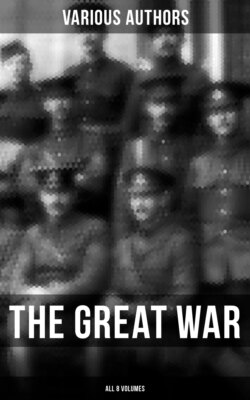Читать книгу The Great War (All 8 Volumes) - Various Authors - Страница 175
На сайте Литреса книга снята с продажи.
CHAPTER LXIII
ОглавлениеTable of Contents
AUSTRIA TAKES THE OFFENSIVE
The Austrians crossed the Polish border on August 29, 1914, and moved on as far as Kielce and toward Radom without encountering serious opposition. That may have been as far as it was intended to proceed. In all three of the armies of Austria there were about 1,000,000 men, and against these forces were arrayed three Russian armies—a small force on the Bug, which may be called the First Russian Army; a Second Russian Army under General Russky, which was moving on Sokal from the Lutsk and Dubno fortresses; and a Third Army under General Brussilov, which was proceeding against the Sereth. There were about 300,000 men in each of the two latter armies.
Now the Russian strategy on September 1, 1914, was this: It was intended that their First Army should retire before Dankl, the Second Army to menace Lemberg from the northeast and put its right wing between Dankl and Von Auffenberg, and the Third Army to advance from the Sereth to the town of Halicz on the Dniester, and so finish the investment of Lemberg on the south and east.
It may have been, though this is not certain, that the General Staff of the Austrians did not see the close connection between the movements of Russky and Brussilov. It may be that they believed they had only Brussilov to face at Lemberg, since Russky would be obliged to proceed to the aid of the First Russian Army on the Bug.
Russky was famed as a highly scientific soldier, being a professor in the Russian War Academy. In the war with Japan, he had been chief of staff to General Kaulbars, the commander of the Second Manchurian Army. Afterward, he had been closely associated with General Sukhomlinoff in the reorganization of the Russian forces. Brussilov, whose army consisted of men of southern Russia, was a cavalry general and had seen service under Skobelev in the Turkish War of 1877. General Ewarts, in charge of the Third Army, the smallest of the three, whose duty was to fight a holding battle, was a corps commander.
No serious resistance was made by the Russians against the main Austrian advance under General Dankl, and it proceeded almost to Lublin. At one time it was within eleven miles of that place.
On August 10, 1914, the Austrians who had crossed the frontier had a front of about eleven miles wide to the west of Tarnogrod. The Russian frontier posts had a brush with the advance cavalry of the Austrians and then fell back. There was a second skirmish at Goraj and a more serious meeting at Krasnik, and the Russians still retreated. The Austrians were jubilant over their victory at Krasnik and at the few delays they encountered at the hands of the enemy. The Russians in their retreat proceeded toward the fortified position of Zamosc or toward Lublin and Kholm.
In the meantime Russia had been gathering an army on the line from Lublin to Kholm. There the Russians had the railroad behind them, in one direction to Warsaw, and in the other to Kiev and Odessa. Each day as the Austrians advanced the strength of the Russian army was improving. In the early days of September, 1914, it probably amounted to 400,000 men.
When the Austrians were within fifteen miles of Lublin they first encountered heavy resistance. They were checked and then delayed, but the Russians were not ready to do more than hold their antagonists. They were waiting for developments farther to the southeast.
On August 17,1914, the Russian offensive had its definite start. General Dankl was finding himself with the First Austrian Army; when he stopped in his advance toward Lublin, General Russky began a powerful attack against Von Auffenberg. Cooperating with Russky, as we have noted, and on his left was Brussilov, the total forces of these two commanders being at first double those with which Von Auffenberg was equipped to oppose them. As soon, however, as Von Auffenberg became aware of the numerical superiority of his opponents, he drew for reenforcements on the Third, or Reserve Army, which had advanced into Poland as far as Kielce.
The latter troops hurried to join Von Auffenberg, crossing the Vistula by means of bridge boats at Josefow. When the issue really was joined, the troops of the Third Austrian Army, under the Archduke Joseph Ferdinand, were ready to act in close cooperation with those of Von Auffenberg. Thus, in the armies on both sides there were, in all, about 1,200,000 men, with the advantage in favor of the Russians. Having this superiority in numbers, Russky felt that he was safe in attempting to envelop the Austrian forces on both flanks. With the larger army—the Second—he hurled his troops at the Austrian left and center, advancing along the railway.
On August 22, 1914, the Russians crossed the frontier and on the following day, Russky occupied Brody, with small opposition. On the same day, Brussilov, on his left, also crossed the frontier at Woloczysk, which is the frontier station on the Lemberg-Odessa railway. At this point the rolling stock used by the Russians on their own railway in their advance was no longer available, as the gauge of the Russian and Austrian lines differs. The Austrians had retired with their own rolling stock in the direction of Lemberg, destroying what they did not take away, and so the Russian advance from that point was continued wholly, perforce, on foot. There was a good wagon road which ran parallel to the railroad toward Lemberg, and along this Brussilov's cavalry hurried.
